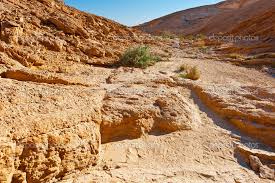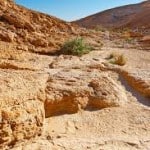The torah begins with a description with the words “G d spoke to Moses and to Aaron, saying: This is the” Chok “of the Torah which G d has commanded.” Numbers 19:2)
The word “Chok” alludes to the segment of commandments that are supra-rational. That is to say that they come from a place that is beyond logic and reason. Our sages describe the laws of the red heifer as being the most supra-rational of all the commandments. This may be so because it is connected to Death . Death after all is the most supra-rational of our life experiences. This fact becomes so painfully clear again as Israel is rocked by another set of Palestinian terror attacks in which a sleeping thirteen year old girl is brutally stabbed multiple times in her bed and a beloved father of ten children is gunned down in front of his children.
The torah portion then moves into another supra-rational event that defies understanding. Moshe hits the stone angrily to give his people water and loses the permission to enter into the much yearned for land of promise. An event that is difficult to understand and to deal with.
In the midst of these narratives we read of another two unusual and mysterious events. Their placement here is not only a function of the chronology of the events but is clearly intended to teach us something as well about how we are to learn to cope with events and experiences that are beyond our ability to grasp.
In the first we read the following
“…., and the people became disheartened because of the way. The people spoke against God and against Moses, “Why have you brought us up out of Egypt to die in this desert, for there is no bread and no water, and we are disgusted with this rotten bread.” The Lord sent against the people the venomous serpents, and they bit the people, and many people of Israel died. The people came to Moses and said, “We have sinned, for we have spoken against the Lord and against you. Pray to the Lord that He remove the serpents from us.” So Moses prayed on behalf of the people. The Lord said to Moses, “Make yourself a serpent and put it on a pole, and let whoever is bitten look at it and live. Moses made a copper serpent and put it on a pole, and whenever a serpent bit a man, he would gaze upon the copper serpent and live. ( Numbers 21:4-9)
The most obvious question is why Hashem would demand the use of a statue of a serpent to bring about healing. Why did it need to be put on a pole.
Rashi brings the words of the sages as an explanation; “Our Rabbis said, Does a serpent cause death or life? However, when Israel looked heavenward and subjected their hearts to their Father in heaven, they would be healed, but if not, they would waste away. — [R.H. 29a]
That explains the placement of the copper serpent on a high pole but why the use of the serpent in the first place?
That was so because they needed to know that their punishment and their healing had nothing to do with serpents. The serpent on the pole reminded the people that the serpents cannot destroy nor can they give life. So when they see the “creature that was more cunning/naked than all other creatures” they should not make the mistake that that image was nothing more than a statue. They needed to be reminded that serpents or idols and images do not bring death nor do they offer life. Our sense of worthiness and ability to march forward into the unknown is completely dependent on being linked to the higher purpose. To go beyond that is which stands before us and go inward and upward into the seemingly unknown and hidden.
We then read of mysterious words regarding the “wars of G-d” ;
“Concerning this will be told in the Book of the Wars of G d: He gave at the Reed Sea and the valleys of Arnon. And the spillage in the valleys when it turned to dwell at Ar and then leaned on the border of Moab. From there to the well; this is the well of which G d said to Moses, “Gather the people and I will give them water.” (Numbers 21:14-16)
We then read how after forty years of travelling through the desert accompanied by the well ,G-d found for them at the beginning of their trek, that the children of Israel raises their voices in praise. “From there to the well; this is the well of which G d said to Moses, “Gather the people and I will give them water.”
It was then that Israel sang this song: “Arise, O well, sing to it.A well dug by princes, carved out by nobles of the people, through the lawgiver with their staffs, and from the desert, a gift. From the gift, to the streams, and from the streams to the heights. From the heights to the valley in the field of Moab, at the top of the peak, that overlooks the wastelands.”(Numbers 21:17-20 )
Why is it that “It was then that Israel sang this song”. What finally happened that prompted this rejoicing and how is it connected to the mysterious words” the Wars of G d: He gave at the Reed Sea and the valleys of Arnon. And the spillage in the valleys when it turned to dwell at Ar and then leaned on the border of Moab.”
Rashi explains that the mountains on either side of the “valley of Arnon “ were close to each other. The Amorites said, “When the Israelites enter the land by passing through the gorge, we will come out of the caves in the mountains above them and kill them with arrows and stones shot from catapults.” G-d enacted a miracle and collapsed the two sides of the valley together killing all the potential attackers hiding in the clefts. Their blood flowed into the streams and became visible in the wells. “And the spillage in the valleys when it turned to dwell at Ar and then leaned on the border of Moab. From there to the well; ”
G-d performed a great miracle and yet it was hidden from the eyes of the people until it was all over.
The word for well (BE-ER) is also the Hebrew word for “explanation”. The well reveals the hidden waters. In the case of Atnon it revealed G-d’s hidden miracles.
That too is an important and critical lesson. That too will be a critical tool to help us overcome the supra-rational events that surround us in our long walk towards destiny.
The world all around us is being shaken through confusion, upheaval and concern. Yet we are to remain focused on the simple truth that Hashem is continuing to guide mankind into their purpose whether it is revealed or hidden in the clouds.
Our continued existence, which in itself defies logic , necessitates our being in touch with those two lessons. The first is to not be detracted by those things before us and remember our purpose and source oif our strength. The second is to trust and depend on G-d’s continued involvement in our journey, whether that involvement is hidden or revealed.
LeRefuat Yehudit bat Golda Yocheved

